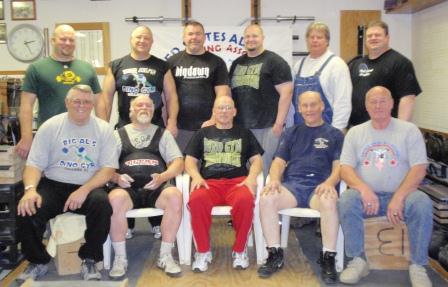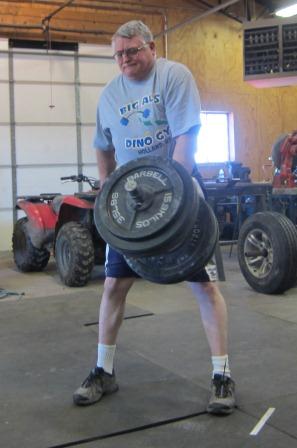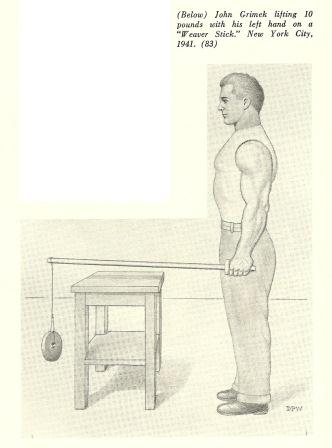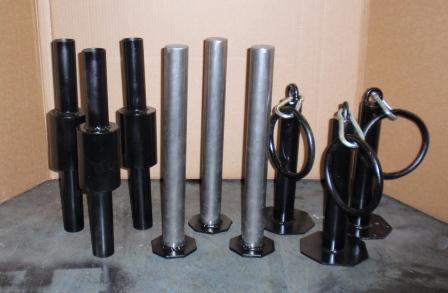Grip Championships
by Al Myers
2012 USAWA GRIP CHAMPIONSHIPS

Group picture from the 2012 USAWA Grip Championships. (front row left to right): LaVerne Myers, Mike Murdock, Denny Habecker, Rudy Bletscher, Dean Ross (back row left to right): Chad Ullom, Al Myers, Darren Barnhart, Scott Tully, Dave Glasgow, Mark Mitchell
MEET REPORT
Saturday was a big day for the Dino Gym! For the second straight year, it was the host site for the USAWA Grip Championships. Eleven lifters participated, and I think every lifter had an enjoyable time. I was expecting a few more, but there were some last minute “drop outs”. All had good excuses (except one which was fishy) for not making their appearance. I was hoping to “upstage” the IAWA(UK) in attendance (they had 18 in their grip champs the weekend before), but we fell a little short of this. I’ll give them kudos this time, but NEXT YEAR will be our turn at grip glory!
We divided up into two different groups to speed up the competition. Since there were FIVE LIFTERS over the age of 60, they lifted together in one group while the rest of us lifted in the other group. By doing this the competition only last 3 hours – and we even took a half hour lunch break!!! I think we spent as much time after the meet presenting the awards and visiting than the meet itself. The meet contained 5 grip lifts which are all official lifts of the USAWA. I thought it was a good selection – but my old buddy Scott thought we should have had a pinch lift in the group. Well next year Scott, I’ll just do that for ya!

LaVerne Myers performing a 165 pound One Arm Fulton Dumbbell Deadlift. This is the top lift in the record books for any lifter over the age of 60!
I want to go over a few individual highlights of the meet. First of all, my dad LaVerne surprised a few with his high placing overall (he was second overall). He has been in training for this so I knew what he could do, and I wasn’t really surprised (maybe worried a little that he would beat me, but not surprised!). He was solid in everything, but almost pulled off the biggest Dumbbell Walk of the day. He had held the gym record in the Dumbbell Walk at 117# before this day, but Darren and I upped it to 122# in this meet. He then tried to get his record back with a 124# effort, and came within a foot of accomplishing it. His 165# One Arm Fulton DB Deadlift was amongst the best of the entire meet. Scott Tully also had an exceptional day. Scott had the top lifts of the entire meet in the One Arm Fulton DB Deadlift (192#), the One Arm No Thumb DL (225#) and the VB Deadlift (394#). Scott tried 416# in the VB Deadlift and came very close to getting it. We did it last and I know his grip was tired by that point which made the difference. Scott has the top lift of ALL TIME in this lift (414#), and I know he has the ability to do more. Scott was also the only lifter in the Senior Division (20-39) and the youngest competitor in the meet.
Chad Ullom was solid in every lift as he always is. Chad doesn’t really have any “weak spots” in his all round game. His Index Fingers Deadlift of 231# tied me for the top lift of the meet in that lift. He did it with more ease than myself, as I tore some skin at the base of my index finger afterwards which wouldn’t stop bleeding. I guess it was worth it as I broke an overall record previously held by Kevin Fulton (225#) as I consider Kevin one of the best finger deadlifters the USAWA has ever seen. The bleeding did affect my performance in the VB deadlift some, but “oh well”. I don’t ever plan to attempt more than this ever again!! (we’ll see…). Darren Barnhart had a great day. Darren didn’t miss a single lift all day and could have done more on several of the lifts. His Dumbbell Walk of 122# was outstanding! Mark Mitchell is one of the best grip guys I know, and in certain grip lifts no one is even close to Mark, but these weren’t the best selection for him. However, he still put up some great numbers and was one of five lifters who put up a total over 1000 pounds. Wait till tomorrow’s story covering the record day and you will see what Mark can do in the Pinch Grip!
Denny Habecker made the long drive from Pennsylvania to compete again this year. Denny pulled in a 6th place overall which is outstanding considering the depth of competition in this meet. Denny was also the lightest lifter in the meet, and the only lifter under 200 pounds. I’ll say this about Denny – having a light bodyweight favors a lifter in a meet when the Lynch Formula is used, but it does not favor a lifter in the after meet party (LOL – inside joke). Mike Murdock and Rudy Bletscher had their usual battle. You never know how things are going to turn out. Rudy edged Mike out this time around. Both of these guys lifted exactly the same weight in all lifts except one (Dumbbell Walk in which Rudy did 10# more). That’s close!! I consider Mike one of the greatest assets the USAWA has gained – he is always there to help out with ANYTHING and you can always count on him for coming through on things. Mike is in the process of developing a computer program for the USAWA scoring and we used it in this meet. His program is getting at the point that all “bugs have been worked out”. It won’t be long and Mike’s program will be available on the website for anyone to use to score their meets.
Dave Glasgow finished very strong with a fourth place overall finish. I could tell Dave was surprised he placed this high – but he did well in all the lifts and it paid off in the end. Dean Ross also made the trip to this meet. There hasn’t been very many all round meets that Dean hasn’t attended this winter and fall. He may be competing in more meets than myself! I always enjoy having Dean at meets because I know I’ll hear a few new jokes throughout the day!
As is the custom of Championship competitions in the USAWA, all age groups were recognized with best lifter awards. I also was glad to give away my “special awards” to the top three BEST LIFTERS in the Senior Division, Masters 1, and Masters 2 Divisions. Thanks to Rudy and LaVerne for declining on of these awards everyone else took home some steel.
BEST LIFTERS
Senior: Scott Tully
Masters 40-44: Chad Ullom
Masters 45-49: Al Myers
Masters 50-54: Mark Mitchell
Masters 65-69: LaVerne Myers
Masters 70-74: Mike Murdock
Masters 75-79: Rudy Bletscher
BEST LIFTERS OF AGE DIVISIONS
Senior (20-39): Scott Tully
Masters 1 (40-59): Al Myers, Chad Ullom, Dave Glasgow
Masters 2 (60 plus): LaVerne Myers, Denny Habecker, Rudy Bletscher
MEET RESULTS:
USAWA Grip Championships
Dino Gym, Holland, Kansas
February 11th, 2012
Meet Director: Al Myers
Officials (3 official system used): Al Myers, Chad Ullom, Scott Tully, Darren Barnhart, Mike Murdock, Dave Glasgow, Denny Habecker, Mark Mitchell, LaVerne Myers
Scorekeeper: Mike Murdock
Lifts: Dumbbell Walk, Deadlift – Fulton Dumbbell One Arm, Deadlift – Fingers Index, Deadlift – No Thumb One Arm, Vertical Bar Deadlift – 2 Bars, 2″
| LIFTER | AGE | BWT | Walk | DB DL | IF DL | DL NT | VB | Total | Points |
| Al Myers | 45 | 247 | 122 | 185R | 231 | 220R | 334 | 1092 | 923.9 |
| LaVerne Myers | 67 | 249 | 112 | 159L | 135 | 185L | 259 | 850 | 864.9 |
| Chad Ullom | 40 | 238 | 102 | 170R | 231 | 210R | 334 | 1047 | 860.4 |
| Dave Glasgow | 58 | 252 | 92 | 160R | 176 | 187R | 294 | 889 | 835.8 |
| Darren Barnhart | 44 | 306 | 122 | 185R | 200 | 209R | 354 | 1070 | 808.0 |
| Denny Habecker | 69 | 187 | 52 | 125R | 120 | 125R | 224 | 646 | 779.3 |
| Rudy Bletscher | 76 | 217 | 77 | 105R | 120 | 140R | 224 | 666 | 779.2 |
| Mark Mitchell | 51 | 360 | 92 | 180R | 220 | 204R | 334 | 1030 | 770.3 |
| Scott Tully | 36 | 346 | 92 | 192R | 187 | 215R | 394 | 1080 | 733.9 |
| Mike Murdock | 71 | 233 | 67 | 105L | 120 | 140R | 224 | 656 | 712.4 |
| Dean Ross | 69 | 274 | 77 | 125R | 140 | 135R | 234 | 711 | 700.8 |
NOTES: BWT is bodyweight recorded in pounds. R and L designate right and left. All lifts recorded in pounds. Total is total points lifted. Points are adjusted points for bodyweight and age.
EXTRA ATTEMPTS FOR RECORDS
Rudy Bletscher: Deadlift – Fulton DB, Right Arm 115#
Denny Habecker: Deadlift – No Thumb, Right Arm 135#
LaVerne Myers: Deadlift – Fulton DB, Left Arm 165#
Dave Glasgow: Deadlift – Fulton DB, Left Arm 160#
Mark Mitchell: Deadlift – No Thumb, Right Arm 210#
Darren Barnhart: Deadlift – Fulton DB, Left Arm 185#
Darren Barnhart: Deadlift – No Thumb, Left Arm 210#
Chad Ullom: Deadlift – Fulton DB, Left Arm 165#
Chad Ullom: Deadlift – No Thumb, Left Arm 198#
Scott Tully: Deadlift – No Thumb, Right Arm 225#


